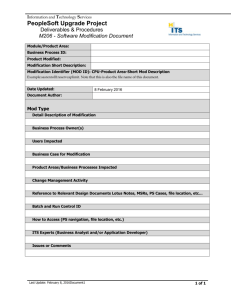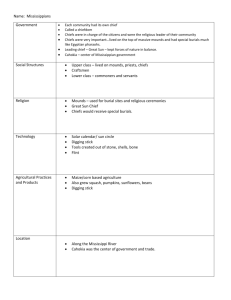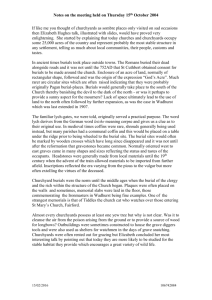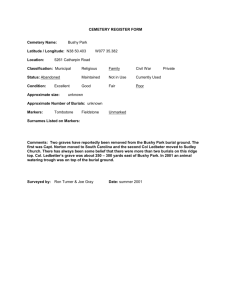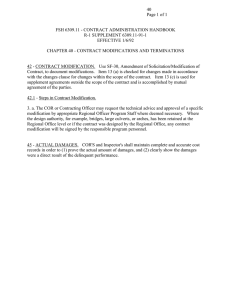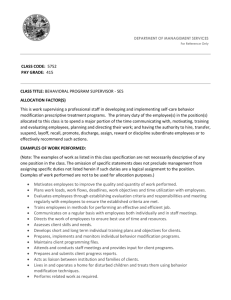Artificial Cranial Modification at the Carson Mounds Site ABSTRACT Amanda N. Bailey
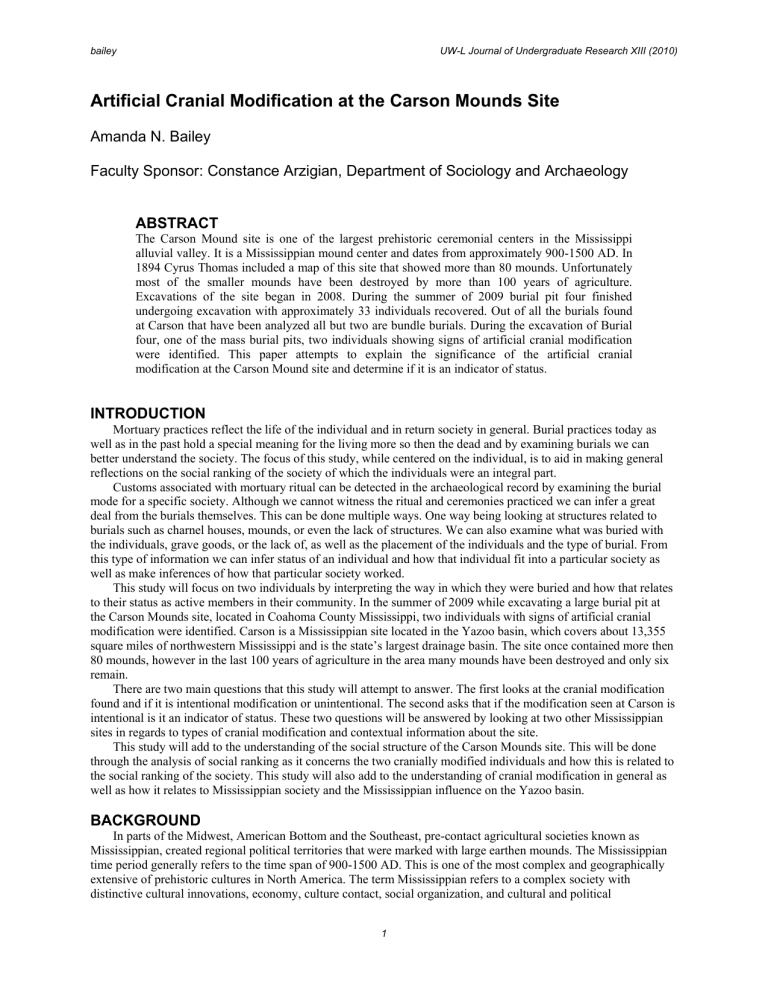
bailey UW-L Journal of Undergraduate Research XIII (2010)
Artificial Cranial Modification at the Carson Mounds Site
Amanda N. Bailey
Faculty Sponsor: Constance Arzigian, Department of Sociology and Archaeology
ABSTRACT
The Carson Mound site is one of the largest prehistoric ceremonial centers in the Mississippi alluvial valley. It is a Mississippian mound center and dates from approximately 900-1500 AD. In
1894 Cyrus Thomas included a map of this site that showed more than 80 mounds. Unfortunately most of the smaller mounds have been destroyed by more than 100 years of agriculture.
Excavations of the site began in 2008. During the summer of 2009 burial pit four finished undergoing excavation with approximately 33 individuals recovered. Out of all the burials found at Carson that have been analyzed all but two are bundle burials. During the excavation of Burial four, one of the mass burial pits, two individuals showing signs of artificial cranial modification were identified. This paper attempts to explain the significance of the artificial cranial modification at the Carson Mound site and determine if it is an indicator of status.
INTRODUCTION
Mortuary practices reflect the life of the individual and in return society in general. Burial practices today as well as in the past hold a special meaning for the living more so then the dead and by examining burials we can better understand the society. The focus of this study, while centered on the individual, is to aid in making general reflections on the social ranking of the society of which the individuals were an integral part.
Customs associated with mortuary ritual can be detected in the archaeological record by examining the burial mode for a specific society. Although we cannot witness the ritual and ceremonies practiced we can infer a great deal from the burials themselves. This can be done multiple ways. One way being looking at structures related to burials such as charnel houses, mounds, or even the lack of structures. We can also examine what was buried with the individuals, grave goods, or the lack of, as well as the placement of the individuals and the type of burial. From this type of information we can infer status of an individual and how that individual fit into a particular society as well as make inferences of how that particular society worked.
This study will focus on two individuals by interpreting the way in which they were buried and how that relates to their status as active members in their community. In the summer of 2009 while excavating a large burial pit at the Carson Mounds site, located in Coahoma County Mississippi, two individuals with signs of artificial cranial modification were identified. Carson is a Mississippian site located in the Yazoo basin, which covers about 13,355 square miles of northwestern Mississippi and is the state’s largest drainage basin. The site once contained more then
80 mounds, however in the last 100 years of agriculture in the area many mounds have been destroyed and only six remain.
There are two main questions that this study will attempt to answer. The first looks at the cranial modification found and if it is intentional modification or unintentional. The second asks that if the modification seen at Carson is intentional is it an indicator of status. These two questions will be answered by looking at two other Mississippian sites in regards to types of cranial modification and contextual information about the site.
This study will add to the understanding of the social structure of the Carson Mounds site. This will be done through the analysis of social ranking as it concerns the two cranially modified individuals and how this is related to the social ranking of the society. This study will also add to the understanding of cranial modification in general as well as how it relates to Mississippian society and the Mississippian influence on the Yazoo basin.
BACKGROUND
In parts of the Midwest, American Bottom and the Southeast, pre-contact agricultural societies known as
Mississippian, created regional political territories that were marked with large earthen mounds. The Mississippian time period generally refers to the time span of 900-1500 AD. This is one of the most complex and geographically extensive of prehistoric cultures in North America. The term Mississippian refers to a complex society with distinctive cultural innovations, economy, culture contact, social organization, and cultural and political
1
bailey UW-L Journal of Undergraduate Research XIII (2010) development. Mississippian societies in the United States possessed elements of social ranking and permanent offices of political and ritual importance. Because there are different levels of rank Mississippian society is considered to be at the Chiefdom level.
A chiefdom level society is normally referred to as a 2-tier society, meaning that there are two levels of peoples: a chiefly or elite class and a commoner class. This is an important concept to understand when dealing with mound sites. Many mounds were ordered to be built by chiefs who would locate their dwellings on top. With dirt being moved with hand woven baskets, the more people a chief had influence over, the bigger the mound would be and the more power he would yield (Ross 2008). Research has been done that suggests that labor must have been necessitated by functional consideration of the prehistoric social system, and the formal diversity reflects a need to maintain many distinct categories (Goldstein 1980). Therefore the elite maintained elite status by exploiting the labor of the non-elite. This is clearly seen in the construction of mounds that are so prevalent on Mississippian sites.
Mississippian sites are generally located along major rivers and streams, or what are now channel scars (where the river once flowed, but over time has cut ridges into the land and slightly changed course). The general location of Carson Mounds can be seen in Figure 1 (Coahoma County) and is located near a channel scar. Mississippian sites are either adjacent to the bottomlands or on natural levees or other elevated locations that would have normally not have been flooded but provided good agricultural land. The presence of many sites located near fertile land as well as the large occurrence of domesticated plants suggests that agriculture was an important aspect of Mississippian society. At Mississippian sites maize, beans, squash, pumpkins, and sunflower are found along with remnants of wild game and fish showing that hunting and fishing were also an aspect of Mississippian subsistence.
Figure 1.
Location of the Carson Mound Group: www.city-data.com/county/Coahoma_County-MS.html
On many sites large ceremonial structures have been found as well as thick middens that suggest that the occupations tended to be long and continuous instead of short habitation sites. This is also reflected of chiefdom societies. Unlike bands and tribes that tend to be more mobile, chiefdoms are more sedentary and tend to practice agriculture, which keeps them tied to the land. This also allows for larger population growth given that agriculture can provide a surplus, which in return can feed more people. Food surplus and a larger population also lead to more
2
bailey UW-L Journal of Undergraduate Research XIII (2010) specialization, meaning that not everyone has to be a food producer. This allows for a more complex society with a more structured hierarchy with rank differences.
Settlements are generally organized in a hierarchical manner. There are generally three or four levels within this organization. The first and highest level of organization would be the large urban center, such as Cahokia. Large urban centers tend to be more diverse with artifacts such as specialized tools. We also see more mortuary diversity in large urban centers. These centers also tend to have a couple of mounds as well as a plaza and perhaps a palisade.
More elites tend to live in the urban centers then any of the other levels. The second level down would be the towns.
The towns tended to have one or two mounds with perhaps a plaza. Towns tend to be less diverse in artifacts, generally having more locally produced artifacts then exotic (made from material not locally available). The third level down are villages were mainly the non-elite would reside. There are generally no elaborate structures such as mounds. The fourth level would be hamlets surrounding the villages and would be single-family occupation sites.
Mississippian Mortuary
Mississippian society was one of the most organizationally complex cultures in prehistoric North America. One way that we can see this complexity in the archaeology data is by looking at the treatment and interment of the dead.
We can see the association between status and how it was recognized in life by the way the funerary treatment was at death (Milner 1984). We can recognize things such as status of the deceased, which includes age, sex, and position in the social organization among other factors (Peebles 1969).
In the Mississippian tradition most individuals were buried in formally defined cemeteries in which there are three main types; outlying community cemeteries, cemeteries of low status individuals that are located in regional centers or towns, and the cemeteries for the elite (Milner 1984). Generally cemeteries tend to be located some distance from habitation areas but not entirely separated from the settlement. Mississippian burials also tend to be in groups that display internal organization. One method of internal organization is the use of space. Space serves as an important dimension used to differentiate burials belonging to various segments of Mississippian society (Milner
1984). For example the elite are generally separated from the rest of the population at the regional centers. Even in non-elite cemeteries we see space used in the structure of the cemetery. Many burials follow patterns such as orientation, which is seen in elite burials as well. Figure 2 displays characteristics of Mississippian cemeteries.
Figure 2.
Characteristics of Mississippian Cemeteries (Milner 1984)
Variability among individuals in the different cemetery types can be most clearly seen among burial goods.
Elites tend to have more grave goods as well as goods made from exotic materials (materials not local to the area).
Most of the large objects are made of exotic/rare materials and are thought to have ceremonial significance (Milner
1984). Non-elite individuals tend to have locally made goods and the amount of goods range from having a good amount to having none at all. The ceramic vessels found in non-elite burials tend to be utilitarian objects that would
3
bailey UW-L Journal of Undergraduate Research XIII (2010) have been commonly used among members of society. Non-elite burials also tend to be organized in a more egalitarian center both in the regional centers and the peripheral areas.
Carson Mounds Site
The Carson Mound Group, located approximately two miles east of Stovall, in Coahoma County, Mississippi has been reported as an Early-Late Mississippian mound center with a possible Middle-Late Woodland occupation
(Lansdell 2009). In the summer of 2008 anthropology professor Jay Johnson (University of Mississippi) and a group of students began work on the Carson Mound site. This site is one of the largest prehistoric ceremonial centers in the
Mississippi alluvial valley (Jay Johnson, personal communication 2009). In 1894 Cyrus Thomas, during his landmark publication on the mounds of eastern United States, included a map of this site that showed more than 80 mounds as seen in Figure 3 (Thomas 1894). Unfortunately most of the smaller mounds have been destroyed by more than 100 years of agriculture in the area and there are currently only six mounds at the site. As seen in Figure 4 of the Carson Mound site we can see that in the past 100 years the site has changed dramatically. Simply put the site is being destroyed by current and past agriculture processes.
Figure 3.
Carson Mounds 1894 (Thomas 1894)
Figure 4.
Carson Mounds (Lansdell 2009)
4
bailey UW-L Journal of Undergraduate Research XIII (2010)
The prehistoric occupation at this site is buried between 20 and 30 cm of sterile flood deposits, and relatively few artifacts are found on the surface. This makes it very difficult to find sites of interest just by surveying the area.
In order to locate areas of interest, geophysical survey had been used by Jay Johnson and his field crew hired by the
University of Mississippi. During the initial excavation of the site the two main goals were to develop appropriate techniques for detecting buried cultural deposits as well as to better understand the resulting imagery provided and the structure of the site itself (Jay Johnson, personal communication 2009). There are many times when geophysical survey is very useful. Geophysical survey data would indicate areas of interest, however once those areas underwent excavation nothing of great importance was discovered. Due to this we also used test pits to help determine areas of interest. The site is still undergoing excavations, which will conclude at the end of the summer of 2010.
Burials at Carson
During the excavations in the summer of 2008 70-80 burials where recovered. During the summer of 2009 burial pit 4 finished undergoing excavation with approximately 30 individuals recovered. Currently Jenna James, a graduate student at the University of Mississippi, is working on recovering data from the individuals recovered from the burial pit. So far all the burials found at Carson that have been analyzed are bundle burials. A bundle burial is a type of secondary burial (being re-buried/ buried a second time) where the flesh is removed either through natural processes such as exposure, or through stripping of the remains, and the clan bones of the individuals are placed in a type of bundle (could perhaps be a basket or other form of bundle) and then buried. What is interesting about this type of burial mode is that the normal Mississippian burial mode differs from what we find at Carson. Most burials found at Mississippian sites are extended primary burials, although bundle burials and mass burials are found
(Goldstein 1980). Extended primary burials are when a person is buried in the flesh shortly after death and the body is placed in an extended position such as in a typical coffin burial.
At Carson there are currently 42 numbered burial pits, and most contain multiple burials. For example one has
19 bundles and burial four has approximately 30 bundle burials. The process that has been established for removing the burials, if the burials are not too tightly packed, is as followed. The burial is generally taken out in blocks after exposing them sufficiently to map and determine their limits so they can be isolated on a pedestal of soil and then can be wrapped with tape and undercut using a steel cable. This is a very delicate process and takes much time to do properly (Jay Johnson, personal communication 2009). However there are occasions, such as with burial four, in which this process is ineffective. The burials are too tightly packed together and cannot be isolated. Therefore the feature must be excavated in the field. This can be a difficult process when trying to excavate in a pit. However excavating a burial that has been taken out in a block can be difficult as well. Once the block is removed and placed in storage the soil hardens and dries out causing there to be cracks which can crack the bones. If done properly though it is expected that you can recover more by excavating a burial in a block.
In the burials that have been excavated there are relatively few grave goods, and in some cases no grave goods are found but only backfill with few pieces of pottery scattered throughout. Grave goods (special artifacts placed with the dead) that have been found along with other artifacts indicate that the burials all took place at the end of the
Mississippian period (around 1300-1500 A.D.), just before the site was abandoned. The geophysical survey data along with the mapped structures suggest that the current excavations are in a portion of the site, which is organized in an unusually regular way and, at least toward the end of the site occupation, was devoted to burial ritual (Jay
Johnson, person communication 2009). Since there are also pits on the site that do not contain burials but contain trash relating to early Mississippian occupation there is the suggestion that the site function changed through time.
This means that throughout the time that the site was occupied (from about 900-1500 AD) the use of the site by people changed.
During the excavation of burial four two individuals showing signs of artificial cranial modification were identified. These two individuals unfortunately could not be taken out in block, but instead were wrapped in a type of cast to preserve the skull. It is perplexing that two individuals showing signs of cranial modification would be in a mass burial pit with relatively no grave goods. It is the attempt of this study to examine if the modification with these individuals was intentional and if so was it a sign of status.
Beaverdam Creek Site
The Beaverdam Creek site (9eB85) is located approximately 0.8 kilometer from the Confluence of Beaverdam
Creek and the Savannah River (Anderson 1994). This site consists of a small mound and an adjacent village area
(approximately 1.5 hectare). This site was inhabited during the Beaverdam phase, a local Mississippian phase, which has been classified as 1200 AD to 1300 AD. Beaverdam Creek is believed to have served as a ceremonial focus for dispersed populations that lived in hamlets and villages in this part of the upper Savannah River basin. It is thought
5
bailey UW-L Journal of Undergraduate Research XIII (2010) that the population of the site that lived there year round would have been small. It is unsure the extent of the influence of Beaverdam Creek to surrounding sites (Anderson 1994).
During the excavations at Beaverdam Creek in the 1980’s 47 burials were recovered. Ten where found in the village area and the remaining from the mound or pre-mound areas (Anderson 1994). The burials found were typically semi flexed or extended and the preservation varied from excellent to extremely poor. Due to the range of preservation age determinations were only possible for 43 individuals. Thirty-one of these individuals were adults,
16 were identified as females and 15 were identified as males.
Out of the 16 identified females nine showed signs of cranial modification as well as one male out of the 15 identified. The type of cranial deformation identified at the Beaverdam Creek site was classified as fronto-occipital.
This type of deformation is typically caused by binding a board to the back of the head of small children, according to the Beaverdam site report. It is unsure if the deformation seen on the male is artificial or due to age-thinning and post depositional warping given he was at least 65 years of age.
Toqua Site
The Toqua Site (40MR6) is located on the south bank of the Little Tennessee River in Monroe County,
Tennessee. Archaeological evidence of occupation within the site ranges from light scatter of lithic materials in outlying portions to dense midden deposits adjacent to two substantial structure mounds (Polhemus 1987). The location of the site would have provided access to a large range of animal, plant, and other resources.
The Toqua Site is a multi-component site with a village area and several mounds and has occupations from prehistoric and historic times (Polhemus 1987). The main occupation of the Toqua site was during the Mississippian period (approximately 900 AD – 1500 AD). This site represents a chiefdom level socio-cultural integration, however the ranking system is not as complex as seen at other sites such as Cahokia.
Investigations at the Toqua site resulted in the excavation of 511 burials (some containing more then one individual). The site contains both mass and single burials as well as different positioning (flexed, semi flexed, etc).
The spatial patterning of the burials within the site is the result of various modes of soico-religious interaction within the community (Polhemus 1987). Out of the 511 burials excavated 123 showed signs of cranial deformation. Only three types of deformation were evident: natural lamboid deformation, occipital deformation, and fronto-verticooccipital (F-0) deformation. The most common type of deformation found was fronto-vertico-occipital (Polhemus
1987).
Artificial Cranial Modification Types
There are many types of modification found in different portions of North America, some identified as intentional and others as unintentional. There is also disagreement between scholars on the naming of different types of modification and how that modification was produced. The term ‘deformation’ is typically used in describing this practice however I am using the term modification. There are two main classification systems that I will be examining. One produced by Neumann in 1942 which is used by the Toqua and Beaverdam site and the other by
Buikstra and Ubelaker in 1994 which is being used at the Carson site. The following descriptions will be coming from the Neumann classification system and are the typical types of modification seen in the southeast.
Occipital deformation is modification of the skull, flattening, at right angles to the ear-eye plane. This type is often asymmetrical and generally doesn’t involve the frontal bones. This type of modification can happen intentionally an in some cases unintentionally. According to Neumann this particular type represents a phenomenon associated with the development of the Mississippi horizons in the southeast. Occipital deformation is seen predominately in protohistoric Mississippian sites in eastern Tennessee (Neumann 1942).
Fronto-Vertico-Occipital deformation (called fronto occipital by Buikstra and Ubelaker) is characterized by flattening of the frontal bone in conjunction with the simple vertical occipital deformation produced by tying the head of an infant to a flat surface (Neumann 1942). This was probably accomplished by means of using a board for the flat surface in which the infants’ head was attached to. In the lower Mississippi valley the earliest record of this particular type of deformation is found in the Cole’s Creek horizon in Louisiana. However this form is also found in
Middle Mississippi sites in central Illinois (Neumann 1942).
Fronto-Parieto-Occipital deformation is characterized by flattening in 3 planes, nearly at right angles to each other (Neumann 1942). In this form compensatory growth takes place laterally instead of superiorly. This type of modification is primarily found in territory occupied by the Cherokee. This includes late Mississippian sites in the
Norris Basin (Neumann 1942).
6
bailey UW-L Journal of Undergraduate Research XIII (2010)
Figure 5 . Types of Cranial Modification (adapted from Neumann 1942)
METHODOLOGY
Human remains from the Carson Mounds site, excavated by Dr. Jay Johnson and his field crew in the summer of 2009, will be discussed compared to other known Mississippian burial populations. The author participated in the excavation of the site, specifically burial pit four. The excavation resulted in the discovery of two individuals with signs of artificial cranial modification. Detailed osteological analysis of the remains of the modified individuals was conducted by Jenna James, a graduate student at the University of Mississippi. She provided the data on the burial pit as well as the individual burials. This included sex, age, burial position, human modification of the individuals found in burial pit four and the dimensions of the pit itself. These data on the two cranially modified individuals from burial four will be described in detail.
To interpret these remains within the context of Mississippian mortuary practices, additional data on age, sex, burial position, cranial deformation, grave goods, status indicators, and context of burial were collected form additional sites. The additional sites include two Mississippian sites: the Beaverdam Creek site in Georgia and the
Toqua site in eastern Tennessee. The Beaverdam Creek site has a total of 52 burials. Out of those burials ten showed signs of cranial deformation, nine of them females and one of them male. The Toqua site has a total of 511 burials and out of those 123 showed signs of cranial deformation.
The data from the Carson Mounds site will be compared to these other populations to see what other contexts are similar, and to facilitate interpretation This includes looking at the type of cranial modification found at all sites, and specifically the interpretation of the modification at the Beaverdam and Toqua sites. By comparing these sites interpretation will be made regarding the modification at the Carson Mounds site.
DATA/RESULTS
Carson Results
The total number of burials at the Carson Mounds site is still to be determined given that the excavation is still ongoing. However this research is specifically looking at the burials in burial pit four. Burial pit four contained 14 bundles, some containing more then one individual (Figure 7). A GIS inventory indicated that there are actually 26 adults based on a MNI of femurs, right and left. Jenna James, graduate student at the University of Mississippi, indicated she was very conservative with her laboratory inventory MNI of long bones, but the GIS results require that she raise the count. This means that there are more skulls the postcranial bodies. In the burial pit there was a total of 33 skulls as seen in Table 1. She is interpreting it as ancestor veneration through retaining skulls from the burial.
7
bailey UW-L Journal of Undergraduate Research XIII (2010)
Figure 6.
Burial Pit 4 (courtesy of Jenna James)
8
bailey UW-L Journal of Undergraduate Research XIII (2010)
Figure 7.
Bundle Burials (courtesy of Jenna James)
9
bailey UW-L Journal of Undergraduate Research XIII (2010)
Table 1.
MNI of skulls in burial pit 4 (courtesy of Jenna James)
MNI of Skulls
Bundle Adult Subadult
F
G
H
I
J
A
C
D
E
K
L
M
N
Z
2
3
2
4
3
4
1
0
0
0
2
0
2
1
1
0
0
1
0
0
0
1
1
0
0
3
2
0
Total 24 9
In the 26 adults identified in the GIS inventory of the burial, eight were identified as female, eleven identified as male, and seven were not able to be identified (Table 2) based on the poor preservation of the burials. As can be seen in Table 2 the age range (based on dentition) for women found in burial pit four ranged from 20 to 30 old and
30 to 55 years old with no females being determined as being over 60 years old. The males are quite similar in age ranges with the exceptions of some being younger then 20, in the 18 to 24 range. When looking at age by using the os coxae of the individual the age range expands on almost all individuals. What is useful about using both types of age determination is that in some cases age cannot be determined by only one method.
Bundle
Table 2.
Adult age and sex of individuals from burial pit 4 (courtesy of Jenna James)
Adult Age and Sex
Sex Age (Os Coxae) Age (Dentition)
A
B *
C
F
G
H
I
J
L
N
Female
Female
Male
Undetermined
Male
Male
Undetermined
Male
Female
Female
Female
Male
Female
Female
Undetermined
Female
Male
Male
Undetermined
Male
Undetermined
Undetermined
Male
Undetermined
Male
Female
40-44yrs
50-59yrs
Undetermined
50-59yrs
40-44yrs
35-39yrs
45-49yrs
Undetermined
Undetermined
35-39yrs
40-44yrs
45-49yrs
30-39yrs
Undetermined
50-59yrs
35-39yrs
50-60+yrs
Undetermined
20-26yrs
30-34yrs
45-49yrs
Undetermined
35-50yrs
40-55yrs
18-24yrs
18-24yrs
40-55yrs
20-30yrs
30-40yrs
30-50yrs
20-30yrs
20-24yrs
20-24yrs
40-50yrs or 50+yrs
40-50yrs or 50+yrs
24-35yrs
24-35yrs
Z Male 30-39yrs 18-24yrs
* Bundle B is not an actual bundle, but an area containing elements of Bundle A & C that cannot be assigned to a single bundle.
10
bailey UW-L Journal of Undergraduate Research XIII (2010)
As stated previously two individuals in burial pit four were identified in the field of being cranially modified
(Figure 8). The type of cranial modification has been identified by Jenna James as fronto-occipital, based on the classification system of Buikstra and Ubelaker (1994). The individuals are from bundle J and bundle I. Jenna has yet to provide me with the sex and age of the individuals. The individuals have not been further analyzed except for what was identified in the field.
Figure 8.
Cranially Modified Individuals (courtesy of Jenna James)
Toqua Results
As stated previously, 511 burials were excavated at Toqua. Out of those excavated 477 have been identified from the Dallas phase and include, approximately 500 total individuals. As six burials were examples of multiple burials they were excluded from the study done by Polhemus (1985). A total of 439 individuals from the excavations were used in the analysis. The site is made up of different components (Figure 9). From the different areas 200 were exhumed from the East Village, 85 from the West Village, none from the South Village, 62 from Mound A, and
Mound B (Polhemus 1985). The analysis looked at the Village component (a total of 285 individuals) and the
Mound component (a total of 139 individuals) separately. From the total individuals exhumed at Toqua a wide variety of ages are seen as well as both sexes, as seen in Table 3. Out of the total 439 individuals 228 were identified as male and 211 as female.
11
bailey UW-L Journal of Undergraduate Research XIII (2010)
Age Interval
0-1
1-5
5-10
10-15
15-20
20-25
25-30
30-35
35-40
40-45
45+
Sample Total
Figure 9.
Layout of Toqua
Table 3.
Age and sex distribution at Toqua (Polhemus 1985)
Age and Sex Distribution of Skeletons From Toqua
Male Female
50
29
14
20
14
31
16
23
17
9
4
228
49
28
23
4
27
30
19
13
9
6
3
211
An individual aged 5 years is considered in the 5-10 year interval.
An individual aged 10 years is considered in the 10-15 year interval and so forth.
Total
99
57
37
24
41
61
35
36
26
15
8
439
12
bailey UW-L Journal of Undergraduate Research XIII (2010)
Out of the burials exhumed from Toqua approximately 123 showed signs of cranial modification (referred to as deformation in the Toqua site report). As stated previously the types of modification seen at Toqua are occipital
(Figure10 and 11), lambdoidal (Figure 12), and fronto-vertico-occipital (referred to as F-0) (Figure 13 and 14). The cranial modification was determined using the classification by Neumann (1942) for North American Indians
(Polhemus 1985). Going off of this classification system it has been determined that the occipital modification is most likely unintentional. Lambdoid modification also appears to be unintentional. The only intentional modification at Toqua has been classified as the F-0 modification (Polhemus 1985).
Figure 10.
Frontal view of occipital modification (Polhemus 1985)
Figure 11.
Lateral view of occipital modification (Polhemus 1985)
13
bailey UW-L Journal of Undergraduate Research XIII (2010)
Figure 12.
Lateral view showing lambdoid modification (Polhemus 1985)
Figure 13.
Frontal view showing F-O modification (Polhemus 1985)
14
bailey UW-L Journal of Undergraduate Research XIII (2010)
Figure 14.
Lateral view showing F-O modification (Polhemus 1985)
In Table 4 Mound and Village frequencies and percentages are presented for the modification categories seen at
Toqua. No differences were seen between the sexes with modification observed at Toqua and therefore were combined in the testing of the two components (Polhemus 1985). The results indicated that 11.8 percent of the
Mound burials had F-0 modification compared to 56.1 percent in the Village. This category shows the greatest disparity. A chi-square test between the components shows that these differences are significant at the 0.05 level ( 𝜒
²
= 13.05). This shows that there was more modification present in the village area where the burials are considered to be of individuals of lower status. This may indicate that the lower status individuals and the higher status individuals viewed cranial modification differently and might have been done for different purposes not related to status.
Table 4.
Frequencies and percentages of cranial modification for combined sexes in mound and village components at Toqua (Polhemus 1985)
Mound Village Totals
Deformation Type
Undeformed
Occipital
Lambdoid
F-O
Totals
Freq.
7
6
2
2
17
%
41.2
35.3
11.8
11.8
12.1
Freq.
21
20
13
69
123
%
17.1
16.3
10.6
56.1
87.9
Freq.
28
26
15
71
140
%
20
18.6
10.7
50.7
--
In structure three at the Toqua site 15 individuals were exhumed and evidence of cranial modification was determined for 10 of the skulls. All 10 were identified as F-O modification. Based on this they conform more to the
Village component. In structure three the individuals are considered to be of high status, and it is likely that this status was achieved rather then ascribed (Polhemus 1985). Achieved status is earned by the individual, whereas ascribed status is when and individual is born with a certain level of status.
Beaverdam Creek Results
As stated previously 47 burials were excavated at the Beaverdam Creek site. Thirty-seven were found either within the mound itself or the premound midden. Ten of the burials were found in the village area. The village burials were typically distributed within a 30 m radius of the Beaverdam Creek mound, primarily toward the south and east (Hally and Rudolph 1985). The preservation of the burials had a broad range; generally mound and premound burials had better preservation. During analysis it was possible to determine the sex of all but two adults
15
bailey UW-L Journal of Undergraduate Research XIII (2010) as well as age and death for forty-three individuals (Hally and Rudolph 1985). The sample included 16 adult females, 15 adult males, 13 children, and two adults of indeterminate sex. Ages ranged from several months to one individual approximately 75-80 yrs old (Hally and Rudolph 1985).
Artificial cranial modification was common at Beaverdam Creek. The majority of modification was seen among females. Nine of the identified females showed cranial modification, as well as one male. It is possible that due to the age of the male the modification thought to be seen is due to age-thinning and post-mortem ground warpage
(Hally and Rudolph 1985). The type of modification was classified using Neumann’s classification system and was determined to be fronto-occipital modification (Hally and Rudolph 1985). As with the Toqua individuals with fronto-occipital modification, this is classified as most likely unintentional modification and this is typically produced by cradle boarding.
DISCUSSION/CONCLUSION
The studies main focus is to determine if the modification seen at Carson Mounds is an indicator of status. In order to determine this the first factor to look at is if the modification is intentional or unintentional. The difference between intentional and unintentional is the practice behind the modification. An example of unintentional modification would be cradle boarding and the resulting modification seen with this is typically occipital modification. This type is classified as unintentional because the purpose of cradle boarding is not to modify the skull, but the modification is a byproduct of another practice.
The modification seen at Carson has been classified as fronto-occipital. This is where the frontal and occipital bone has been flattened. This type has also been called fronto-vertico-occipital as it is classified at Toqua. This type of modification is more complex then simple cradle boarding could produce and could not have been naturally produced. Also during the excavation of the two cranially modified individuals it was determined that the modification was not produced post mortem. Based on this I have determined that the cranial modification at the
Carson Mounds site is intentional modification
At the Toque site we see three different types of modification as well as intentional and unintentional modification. It was determined that the unintentional modification was most likely a result from cradle boarding and the intentional modification done for cosmetic purposes. In this case we do not see status among individuals that have cranial modification. There was also a significant difference from the modification from the Mound area and the Village area. This possibly reflects that high status individuals didn’t view the practice the same way that low status individuals did. In this sense the cranial modification supports the model of ascribed status that is indicated at the site.
At Beaverdam Creek only one type of modification is seen, and is confined mainly and possibly exclusively to females. Those with modification where all in single burials and a large portion containing grave goods. Also all except one were located in premound areas and the other in a mound area. It has been determined that Interment in the earthlodges and platform mound stages or in the vicinity of these structures was an indication of status (Hally and Rudolph 1985). Based on this contextual information it is determined that the modification here was an indicator of status.
Based on the information at these sites I would expect to see status among individuals in special locations such as mounds or premound areas, to have the burials spatially differentiated, and associated grave goods, as well as one main type of intentional modification. At Carson we do see the one main type of intentional modification, frontooccipital, however the other indicators are absent. The bundles in burial pit four were so tightly packed together that no spatial distinctions could be made. Also the burial pit contained no grave goods that would indicate status. From these factors it is conclude that with the current information the cranial modification at the Carson Mounds site is not an indicator of status.
This interpretation could however change with the ongoing excavations at Carson, as well as determining if the two modified skulls are part of a postcranial body. As stated previously. Jenna James has interpreted the extra skulls in the burial pit as ancestor veneration. What is not clear at this time is if the two modified skulls are part of a full bundle burial. In this aspect I have assumed that they are part of a postcranial body to make my interpretations of the modification not being an indicator of status. However if further analysis shows that these two individuals do not have a postcranial body then the interpretation could change. In this instance it could be interpreted as status or perceived status by the other individuals of the time.
There could be possible other explanations for the modification found at Carson. For instance modification for cosmetic purposes such as we see at Toqua. However if it were for this purpose it would be expected to find more types of modification as well as more individuals showing signs of modification. It is possible, however, that further excavations at Carson that more individuals with cranial modification will be found. It is also possible, assuming that the skulls are part of a postcranial body, that the modification could be a result of a dying out practice, which is
16
bailey UW-L Journal of Undergraduate Research XIII (2010) why we only see two individuals with the modification. This is possible given that the burial is thought to be part of the latter occupation of this site towards the end of the Mississippian period. However we cannot definitely date this site due to the lack of artifacts found in the burial pit.
For further analysis on these skulls it would be interesting to do isotope analysis on the remains to determine whether the individuals had a better diet then the other individuals within the pit. If done this could provide better insight towards the question of status concerning the two individuals with cranial modification. If done at other sites this could be a very useful tool in comparing burial populations and better understanding status.
With this study there were some limitations the biggest being that the site is still undergoing excavations and the burials recovered are still undergoing analysis. However hopefully this research will help to better understand the
Carson site and its relation to other sites in the area as well as in the broader context of the Mississippian time period. The other main limitation is that the two modified skulls have not been further analyzed since being identified in the field. There is also a limitation within the ways in which to identify cranial modification. In the two systems used (Neumann 1942 and Buikstra and Ubelaker 1994) not much is given in order to classify modification of skulls. Figures of modification types are given and very brief descriptions if any at all explaining the type of modification. There is much still to learn about the practice of cranial modification and its implications that it had among the societies in which it was practiced as well as the classification systems in which we use in our interpretations of modification.
ACKNOWLEDGMENTS
I would like to thank the following people for their support while doing my research: Firstly, to Constance
Arzigian, for guiding me through my research and reading my many drafts; Secondly to Dr. Anderson for also reading many drafts of my research and helping me put everything in the proper order; Lastly to the UW-La Crosse
Undergraduate Research Committee for giving me the resources in which to do this type or research project.
REFERNCES CITED
Anderson, David G. 1994 The Savannah River Chiefdoms: Political Change in the Late Prehistoric Southeast.
The
University of Alabama Press, Tuscaloosa, Alabama.
Beck, Robin A Jr. 2003 Consolidation and Hierarchy: Chiefdom Variability in the Mississippian Southeast.
American Antiquity 68:641-661.
Binford, Lewis R. 1971 Mortuary Practices, Their Study and Their Potential. Society for American Archaeology,
Memoir 25:6-29.
Blitz, John H. 1999 Mississippian Chiefdoms and the Fission-Fusion Process. American Antiquity 64:577-590.
Blitz, John H. and Patrick Livingood. 2004 Sociopolitical Implications of Mississippian Mound Volume.
American
Antiquity 69:291-301.
Cobb, Charles R. 2003 Mississippian Chiefdoms: How Complex? Annual Review Anthropology 32:63-84.
Emmerson, Thomas E. and Eve Hargrave. 2000 Strangers in Paradise? Recognizing Ethnic Mortuary Diversity on the Fringes of Cahokia. Southeastern Archaeology.
Hall, David J. 2004 Mortuary Patterns at a Sixteenth-Century Town in Northwestern Georgia. Southeastern
Archaeology 24:166-177.
Hally, David J. and James L. Rudolph. 1985 Archaeological Investigation at the Beaverdam Creek site (9EB85)
Elbert County, Georgia. U.S. Department of the Interior National Park Service Archaeological Service Branch-
Atlanta.
Hammerstedt, Scott W. 2005 Mississippian Status in Western Kentucky: Evidence from the Annis Mound.
Southeastern Archaeology 24:11-27.
King, Adam. 2004 Deciphering Etowah’s Mound C: The Construction History and Mortuary Record of a
Mississippian Burial Mound. Southeastern Archaeology 23:153-165.
Knight, Vernon James Jr. 1986 The Institutional Organization of Mississippian Religion. American Antiquity
51:675-687.
Milner, George R. 1984 Social and Temporal Implications of Variation Among American Bottom Mississippian
Cemeteries. American Antiquity 49:468-488.
Milner, George R. 1986 Mississippian Period Population Density in a Segment of the Central Mississippi River
Valley. American Antiquity 51:227-238.
Peebles, Christopher S. 1969 Moundville and Surrounding Sites: Some Structural Considerations of Mortuary
Practices II. Society for American Archaeology, Memoir 25:68-90.
17
bailey UW-L Journal of Undergraduate Research XIII (2010)
Polhemus, Richard R. 1985 The Toqua Site: A Late Mississippian Dallas Phase Town. University of Tennessee,
Department of Anthropology. Reports of Investigations Number 41.Tennesse Valley Authority.
Rothschild, Nan A. 1979 Mortuary Behavior and Social Organization at Indian Knoll and Dickson Mounds.
American Antiquity 44:658-675.
Sears, William H. 1958 Burial Mounds on the Gulf Coastal Plain. American Antiquity 3:274-284.
Sprague, Roderick. 1968 A Suggested Terminology and Classification for Burial Description. American Antiquity
33:479-485.
Thomas, Cyrus. 1894 Report on the Mound Explorations of the Bureau of Ethnology. In Twelfth Annual Report of the Bureau of Ethnology, 1890-1891. Government Printing Office, Washington, D.C.
Trinkaus, K. Mauerer. 1984 Mortuary Ritual and Mortuary Remains. Current Anthropology 25:674-679.
18

